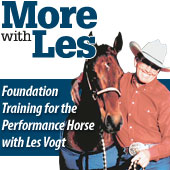 Fourteenth in a series
Fourteenth in a series
After looking at ways toward a lighter touch in our hands last issue, Les coaches us on our seat.
When you see an equine athlete performing, you’ll notice that although they exhibit tremendous power, every movement is fluid and relaxed. There is no tension or stiffness anywhere. If this type of performance is your ultimate goal, the first thing you need to check on is your own riding. When you ride are you fluid and relaxed, with no tension or stiffness anywhere? Many novice riders get so focused on a particular movement that they end up carrying a lot of tension in different parts of their body, shoulders in particular. Stiffness in the rider results in movements and cues that are laborious and abrupt instead of smooth and flowing, and this will result in resistance and stiffness in the horse’s movements as well. This is why many of the exercises in this first section are designed to help you develop your feel and learn to stay relaxed in the saddle.
Here’s the first one:
Saddle up your horse and head for the round pen, or just put him on a longe line. Then ask him to pick up the lope. As he’s going around, take a good look at what the stirrups are doing, how they are bumping against his sides in timing with each stride of his lope. Now imagine you are in the saddle and your legs are so relaxed that they are assuming the same rhythmic movement as the stirrups, as the horse lopes along.
Now get up on your horse and try it. If you have a round pen, it’s a great place to try experiment, as you’re not worried about steering at the same time. Make sure as you try this exercise, you really relax and follow the horse’s movements You’ll want to maintain just enough pressure in the stirrup to keep your foot in it, but do it in a relaxed way, without feeling like you’re forcing anything into position.
As you do this, don’t try to duplicate the horse’s movement using your own muscles, just let your leg and your seat naturally move with the rhythm of the horse. At first, your horse might be a little concerned as your calf makes contact with his side, but he should soon relax and enjoy the rhythm.
Once you’ve become comfortable with the rhythm, try speeding your horse up simply by adding a slight bump with your legs at the point that your calf naturally comes into contact with your horse’s side. Practice this for the next few weeks until your legs are relaxed and able to move with the horse.
EDITOR’S NOTE: More with Les is a regular California Horsetrader column. Les Vogt has won more than 15 World Championships, including two wins at the NRCHA Snaffle Bit Futurity. Although Les still rides and occasionally shows, his focus is giving clinics around the world and developing products for the performance horseman. To learn more about Les and to see his clinic schedule, visit: www.lesvogt.com
Leave a Comment
All fields must be filled in to leave a message.